

D23
ATLANTIC 1944
ARCTIC 1945
NORWAY 1945
Builder: Seattle-Tacoma Shipbuilding Co. Tacoma, Washington.
Completed by: Willamette Iron & Steel, Portland, Oregon
Displacement: 15,390 tons
Length (Overall): 494ft 9in
Beam: 69ft 6in
Draught: 16 ft
Flight deck: 450ft x 80ft wood covered mild steel plate
Propulsion: 2 Foster Wheeler boilers; 1 x Allis-Chalmers geared turbine driving 1 shaft
Speed: 18 knots
A/C Capacity: 20
Hangar: 260ft x 62ft x 18ft
A/C lifts: 2, Aft 34ft long x 42ft wide; forward 42ft long x 34ft wide
Arrestor wires: 9 with 3 barriers
Catapult: 1 H4C hydraulic
Armament: 2 single 5in USN Mk 12, 8 twin 40mm Bofors, 14 twin 20rnm Oerlikon, 7 single 20mm Oerlikon
Crew Complement: 646
Cdr. E. M. McCausland RN
Sep - Nov 43
Capt. R. J. Gardner RN
Nov 43 - Apr 46
856
Sep 44-Jun 45
Avenger I/Wildcat V/VII
881
Dec 44-Jan 45
Wildcat VI
1835
Corsair
None
None
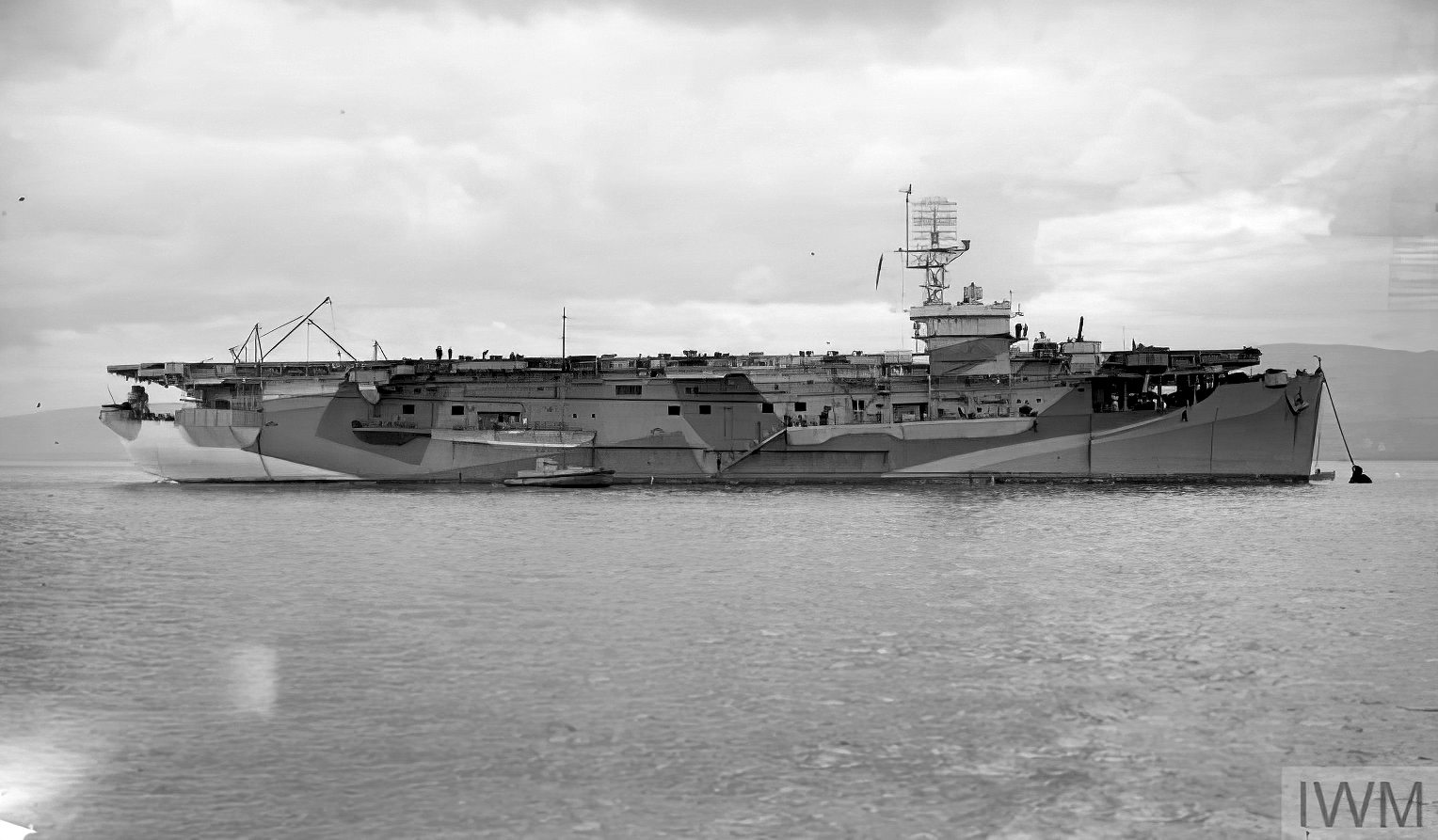
HMS PREMIER moored on the Clyde March 23rd 1944. Photo: © IWM (A 22527)
HMS PREMIER was an ‘Ruler’ class escort carrier, her keel was laid October 10th 1942 at Seattle-Tacoma Shipbuilding Co. Tacoma, Washington, a Maritime Commission C3-S-A1 type freighter, Maritime Commission hull number 253, Seattle-Tacoma hull number 37; the hull was purchased by the US navy to become the auxiliary aircraft carrier USS ESTERO ACV-42; she was launched on March 22nd 1943 by her sponsor Mrs. C. N. Ingraham and was assigned to Willamette Iron & Steel, Portland, Oregon, for the completion of her construction as an escort carrier; the completed hull being towed by tugs from Seattle to Portland. Her USN designation changed from ACV to CVE on July 15th 1943.
In October 1943 CVE-42 was transferred to the United Kingdom under Lend Lease and delivered on November 3rd 1943 at a ceremony held on the flight deck. The ship was accepted on behalf of the US Navy by Captain L. D. Whitgrove USN, Supervisor of Shipbuilding at Portland and after the playing of the American national anthem he delivered her to Commander E.M. McCausland RN who accepted her on behalf of the Admiralty. Commander McCausland read out the order commissioning her as HMS PREMIER (pennant number D23) and the White ensign and the Union Jack were hoisted accompanied by the British national anthem; a short church service followed.
After completing her builder's sea trials and Admiralty acceptance tests HMS PREMIER proceeded to Vancouver, Canada to be modified to meet Admiralty requirements, calling at US Naval Station Astoria November 16th and arriving at La Pointe Pier, North Vancouver, British Columbia on the 18th. On completion she would receive her full crew compliment (PREMIER had only a skeleton crew drafted to her at Portland due to manpower shortages), and work up ready for beginning her active service.
The modification work was undertaken by the Burrard Dry Dock Co. Ltd., North Vancouver, British Columbia. PREMIER was the seventh ship to be modified by Burrard's, and on arrival at Vancouver she was secured at No 3 berth, Lapointe Pier; at this time sister CVEs BEGUM, EMPRESS, SHAH, NABOB and RANEE were in the hands of the Burrard's yard and at various stages of modification. Captain R.J. Gardner RN arrived on board once she was secured in Vancouver and assumed command.
Work commenced straightaway to de-store the ship and her alteration work began the following day: this work totalled 150 separate modifications and included lengthening of the flight deck, fitting redesigned flying controls and fighter direction layout, modifications to hangar, accommodation and store rooms, installing extra safety measures including major changes to the aviation fuel stowage and oiling at sea arrangements,, modifying gunnery and other internal communications, adding extra W/T and R/T sets, and improved darken ship arrangements.
As work progressed PREMIER moved through the yards various berths; the yard could be working on six different ships at any time with separate aspects of the work carried out at different berths, the ships passing through like a production line, moving from one berth to another until complete. PREMIER moved to No 4 on November 20th, then to No 5 on November 27th. The ship entered Burrard's floating dry dock on December 7th for the fitting of additional sea valves and other remedial work before returning to No 3 berth after undocking on the 10th. She returned to No. 4 berth on December 20th, and then on to No. 5 again on the 28th where her alterations were to be completed on January 9th 1944.
Although the alteration phase of her work was now complete PREMIER was still under repair at this time as she awaited the arrival of a replacement Low Pressure turbine assembly; all of the class suffered from defective LP rotors and they required re-milling of the gear teeth to correct the problem. Later ships had the problem resolved at the Seattle-Tacoma yard or in Portland, but PREMIER and earlier delivered vessels had to be corrected while in Vancouver. Her replacement rotor arrived on January 3rd and work to fit it began straightaway; the work was not completed until the 14th when her engines were tested prior to her being moved to a mooring in the stream the following day. Including holidays, PREMIER spent 57 days in dockyard hands.
A few days later PREMIER sailed for Esquimalt, Victoria, North Vancouver to store ship and prepare for her work up and post modification shakedown: she also made a round trip to the US Naval Yard at Bremerton, Washington to ammunition the ship, arriving in Sinclair inlet on January 25th; she sailed on the 27th to return to the Straits of Georgia (between Vancouver Island and the mainland), for steaming, gunnery, radar and other trials and exercises on the 28th. On her return to Esquimalt she embarked Confidential Books and more stores.
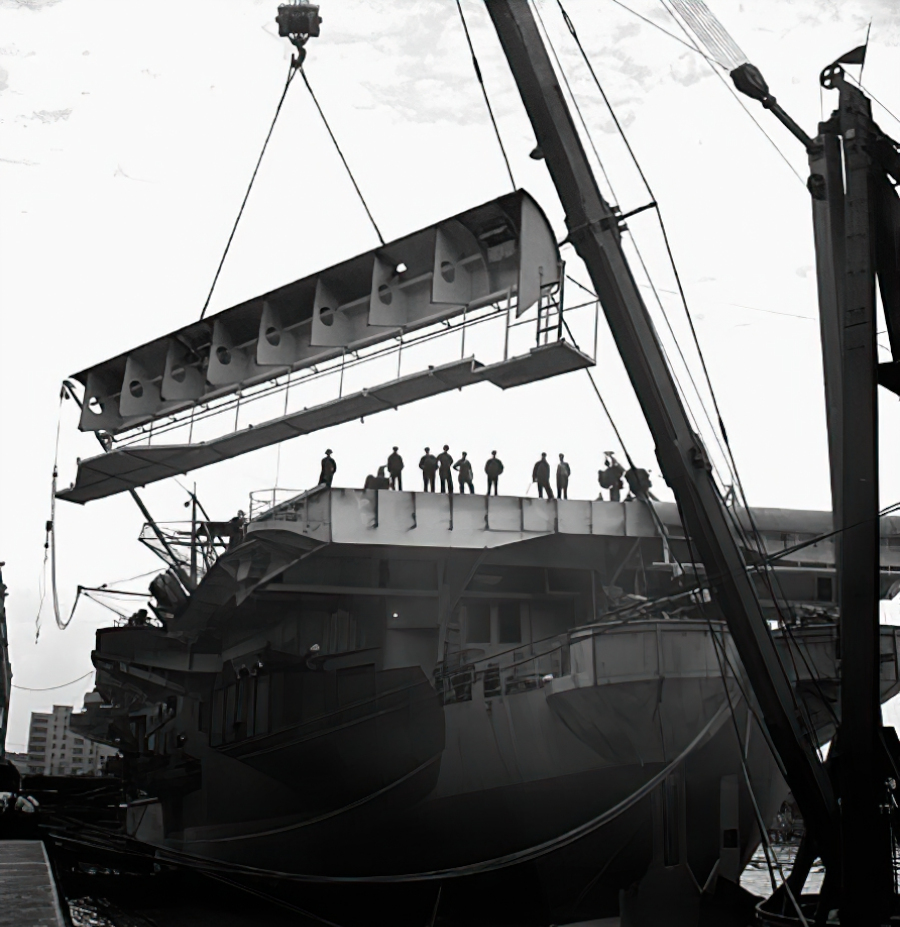
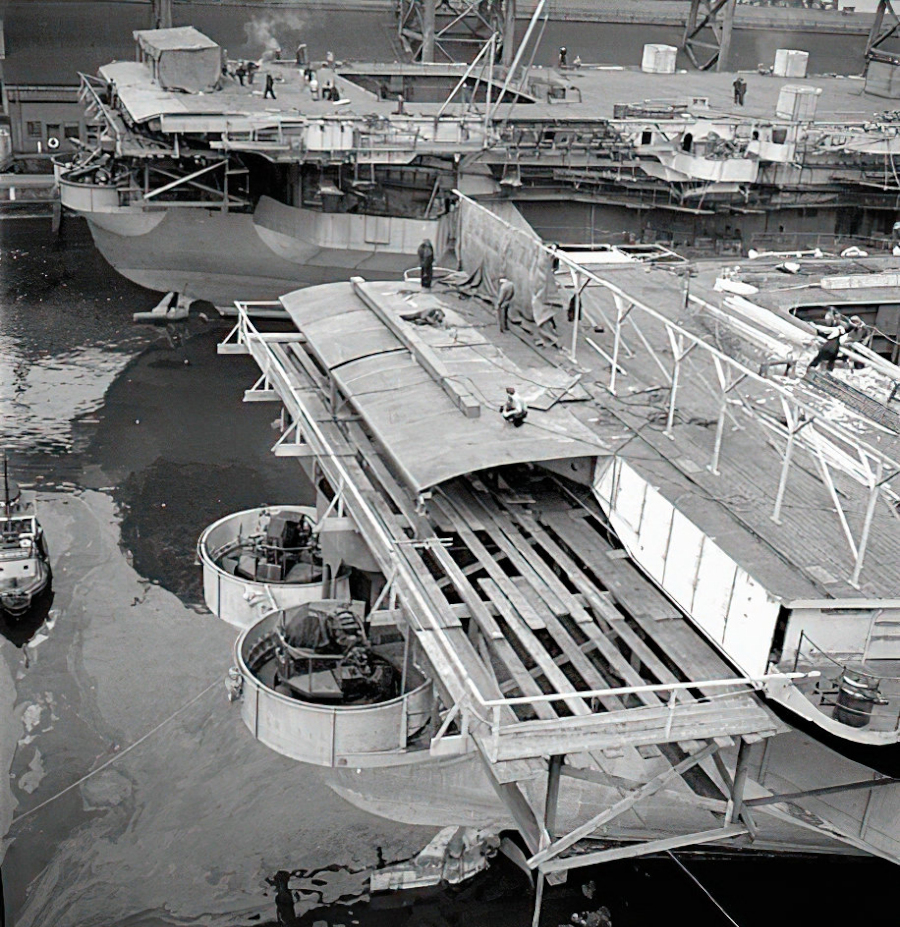
HMS PREMIER departed from Esquimalt on her maiden voyage to the UK on February 5th, calling at Norfolk, and New York. She arrived at Balboa on February 17th and passed through the Panama Canal. She sailed from Cristobal on the 19th, arriving at the Naval Operating Base Norfolk Virginia, on the 25th. At Norfolk she embarked a ferry load of Lend-Lease American airframes for delivery to the UK, and once loading was completed PREMIER sailed for New York on March 6th to await a UK bound convoy. On March 7th she was taken in hand the Bethlehem Steel company for voyage repairs at the 35th street pier, Brooklyn; the work was completed on the 9th. She joined convoy CU 17 which departed from New York on the 16th and arrived in Liverpool Bay on the 26th.
After unloading her aircraft at Gladstone Dock PREMIER was allocated to Western Approaches Command for duty as a ferry carrier; she was ordered to make a return voyage to Norfolk for a second load of aircraft via the Azores, where she was to deliver a consignment of RAF aircraft. The short range aircraft, 8 Spitfire Mk.Vs, 5 Martinets and 2 Walrus, of B' Flight No 269 Squadron RAF, and their aircrews, were hoisted aboard and the ship sailed from Liverpool on March 28th. PREMIER arrived off Terceira, in the Azores Islands on April 4th and the aircraft and crews of 269 Squadron were flown ashore to RAF Lagens; none of the pilots had ever flown from a carrier deck before but all aircraft successfully left the deck and landed ashore.
The ship continued on to Bermuda before reaching Norfolk, on the morning of the April 11th where work began loading aircraft. After all stores and cargo were loaded she proceeded to New York, sailing at 20:42 on the 12th. She joined convoy CU.21 on April 15th bound for Liverpool, arriving there on the 26th to unload.
After unloading the ship moved to the Clyde to store ship and prepare for her third and final ferry trip, she joined the New York bound convoy UC 21 which left Liverpool on May 2nd 1944. On the 11th PREMIER and her escort broke off from the convoy and proceeded to Norfolk, arriving there the following day. A week later, carrying another ferry load of aircraft and stores she sailed for New York where she arrived early in the morning on May 20th and proceeded to 56th street pier, Brooklyn for minor voyage repairs carried out by the Bethlehem Steel company; these were completed the following day. She sailed to join convoy CU.25 on the 21st for the crossing to Liverpool. HMS PREMIER arrived in Liverpool on May 31st and after unloading she was taken in hand by Messers, Rollo's & Grayson, ship repairers for a period of defect rectification and modification.
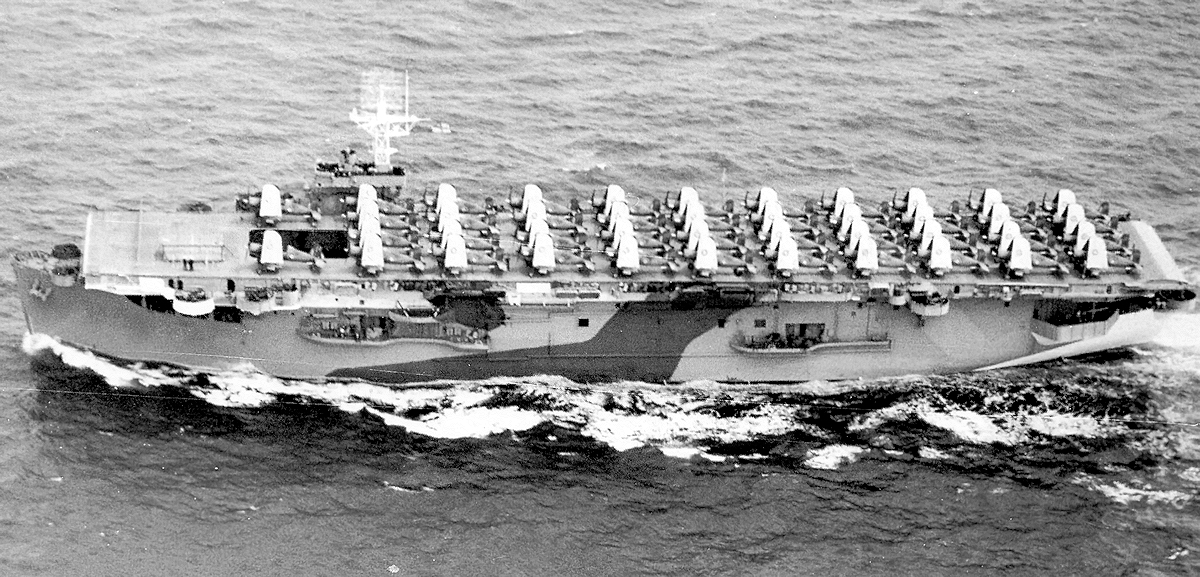
HMS PREMIER on aircraft ferrying duty c.1944, she is carrying a full load with 42 Corsairs on her flight deck and others stowed in her hangar.
PREMIER entered Alexandra Dock on June 7th and was to spend the next three months in dockyard hands; in April additional work had been ordered by the Admiralty for all of the 'Ruler' class ships. One of the largest of these was the upgrading of the close-in weapons fit; all the single 20mm Oerlikon guns on the Gallery Deck and foc'sle deck were to be removed and fourteen Twin 20mm Oerlikon Mountings fitted. Work was completed on September 5th and PREMIER was re-designated as an operational 'Trade Protection' or 'general purpose' carrier under the control of Western Approaches Command.
PREMIER left Liverpool for Bangor, Northern Ireland on September 11th and anchored in Belfast Lough in preparation for embarking her squadron from RNAS Eglinton. The following day the personnel and equipment of 856 naval Air Squadron were embarked, the work was completed by 16:00. PREMIER put to sea to receive aircraft on the 13th when 856 flew out to join the ship from equipped with 12 Avengers & 4 Wildcats.
She began her work up period in the Clyde exercise areas and her squadron took part in anti-submarine (A/S) exercises, day and night deck landing training, Navigation exercises and anti-submarine strikes. This period also put the ship's air department through its paces, her inexperienced flight deck parties were finally getting some intensive training; the flight deck of a carrier is a dangerous place, one crew member discovered this on September 21st when he was blown over the rounddown by the force of a Wildcat's slipstream as its engine was put to full throttle. Luckily he was rescued uninjured by the plane guard vessel. The ship returned to the Clyde later that day, securing to a buoy at Tail of the Bank.
She was back at sea again two days later for more exercises and was inspected by Flag Officer Carrier Training (FOCT) on the 26th, the Admiral and his staff were flown aboard from RNAS Ayr by 856 Squadron aircraft, and returned there later the same day. PREMIER was back at Tail of the Bank to store ship on October 2nd before beginning another round of beacon exercises on the 5th and anti-submarine strike exercises on the 6th and 7th. On the 8th PREMIER's flight deck parties experienced their first serious flying accident when Avenger JZ536 flown by Sub-Lt H. T. L. Babonau, RNVR missed all the arrestor wires, jumped both barriers and finished up colliding with Avengers JZ530 and JZ531 parked forward. All three airframes were write offs, but there were no injuries.
FOCT staff visited the ship again on October 9th and remained aboard until the 12th when a final inspection was carried out which included Fighter tests and practice A/S strikes, A/S attacks astern of the ship with bombs and depth charges, fighter interceptions and night navexes. The work up concluded with detection exercises with submarine fitted with dummy snorkel on the 13th and gunnery exercises on the 14th. The ship returned to Greenock on October 16th and a week's leave was granted while the ship underwent a short maintenance period prior to the returning to Rothesay for a final round of exercises on the 28th. On the 31st Six Avengers were flown to
RNAS Machrihanish for compass swinging and a final round of night deck landings were carried out; the ship returned to Tail of the Bank on November 3rd.
PREMIER sailed for Scapa Flow on November 9th, and on her arrival there the following day she was transferred to the strength of the Home Fleet. The captain addressed the ship's company at divisions on the flight deck on the 12th and outlined the tasks facing the ship and her squadron in operations off Norway. She was to be at sea again on the 15th for her squadron to practice aerial mine laying off the island of Papa Westray in Orkney using smoke flares as substitute mines.
Operation HANDFAST: On November 19th a small force, Force 3, comprising of the Cruiser DIADEM, CVEs PREMIER and PURSUER with the destroyers ZEALOUS, ONSLAUGHT, SCOURGE and SCORPION left Scapa Flow for Operation "HANDFAST", aerial minelaying in Salhusstrommen near Haugesund, Norway by 856 Squadron's Avengers with fighter protection provided by the Wildcats of PURSUER's 881 Squadron. For the mine laying operation 856 flew 9 Avengers and her 4 Wildcats, these were joined by 8 Wildcats from 881 providing High cover and a further 8 for low level cover. The operation was executed on the 20th and the aircraft encountered light, inaccurate flak which caused light damage to one Avenger which was unable to drop it's mine. Of the 8 other mines laid in Kara Sound 7 were placed correctly. All aircraft returned to their carriers safely and the force returned to Scapa Flow departing the area the same evening.
Operation PROVIDENT: PREMIER was not in port long, she was back at sea two days later as part of a force comprising the fleet carrier IMPLACABLE, CVE's PREMIER and PURSUER and the Cruiser DEVONSHIRE, with escorting destroyers MYNGS, SCOURGE, ZEPHYR, SCORPION, SCOURGE, SIOUX (RCN) and ALGONQUIN (RCN) for operation PROVIDENT, to carry out air attacks against coastal convoys between Mosjoen and Rorvik off Norwegian coast.
The force left Scapa on the 22nd but ran into heavy weather by the 24th which hampered operations; severe gales brought winds of 60+ knots over the flight deck and all aircraft on the CVEs had to be securely lashed down in the hanger. Bothe PREMIER and PURSUER suffered damage to their flight decks as the heavy seas and winds tore away planking and bent steel support struts; unable to operate aircraft both carriers, in company with DEVONSHIRE with an escort of five destroyers, returned to Scapa Flow, arriving there on the evening of the 25th. IMPLACABLE and her escorts remained at sea and did manage to engage enemy shipping.
Repairs to PREMIER's flight deck were in had the following day and it was possible to launch all of 856 Squadron's sir craft using the ship's accelerator on the 27th; the squadron was sent ashore to RNAS Hatston where it received an additional 4 Wildcats.
Operation URBANE: PREMIER was next at sea as part of Force 1, comprising the fleet carrier IMPLACABLE, Cruiser DIADEM, HM Escort Carriers TRUMPETER and PREMIER, Destroyers ZAMBESI, SAVAGE, VIGILANT, ZEALOUS, SERAPIS, SIOUX (RCN), ALGONQUIN (RCN) and Norwegian destroyer STORD sailed for a shipping strike off Hagesund and a repeat air mine laying sortie in Kara Sound, Operation "URBANE". For this operation her aircraft complement was adjusted so that she carried only Avengers; her own 12 aircraft flew aboard while at anchor in Scapa Flow on December 5th, they were joined by a detachment of 5 Avengers from TRUMPETER's 846 Squadron which were displaced by 856's Wildcat light (now 8 in number) which was to operate from TRUMPETER for Operation URBANE.
The force set sail on the 6th and were in position to begin operations on the 7th with aircraft being launched in the afternoon. PREMIER's Avengers successfully laid 10 mines while the Wildcats attacked several targets, including a factory, a shore battery and a radar station. 856 was to suffer their first operational fatality during Operation URBANE, Lt W. S. Vittle, RNVR was killed when his Wildcat (JV674 'P-V') failed to return to TRUMPETER after the operation, his aircraft was seen to be trailing smoke after being hit by flak and ditched off the coast. On the 8th aircraft carried out attacks on shipping between Bergen and Stavanger before Force 1 disengaged and headed for Scapa Flow, arriving back there on the morning of the 9th.
Local leave was granted once the ship was secured and preparations began for a third mine laying sortie and shipping strike, Operation LACERATE which was scheduled for December 12th.
Operation LACERATE: The ships for this operation formed Force 2, comprising the Cruiser DEVONSHIRE, CVEs PREMIER and TRUMPETER, Destroyers ZEALOUS, ZEPHYR, SAVAGE, SERAPIS, SIOUX (RCN), and ALGONQUIN (RCN). On the 11th a detachment of 2 Wildcats of 881 Squadron was embarked.
Force 2 put to sea on December 12th, this time both carriers were equipped with 6 Avengers and 8 Wildcats which were in action on the 14th laying mines in the shipping channels off the Norwegian coast. Two enemy W/T and signal stations were also destroyed by aircraft gunfire. On return from the mission the Wildcats provided Combat Air Patrols (CAP) over the force and these were alerted at dusk by 6 German aircraft which approached but veered off without attacking. A planned second phase of air minelaying operations in Skatestromme on the 15th was cancelled when severe gales again caused damage to the flight decks of both carriers, one aircraft that was ranged on deck was lost overboard; as a result the force withdrew to Scapa Flow, arriving there at 18:00 on the 16th. The 881 Squadron detachment was disembarked on reaching Scapa.


After her return to Scapa Flow PREMIER was assigned to a Clyde shipyard for much needed repairs and preparations were made for passage to Greenock. After loading damaged aircraft as deck cargo for delivery to the Aircraft Repair Yard at Donniebristle PREMIER sailed from Scapa Flow on the 21st.
PREMIER was moored at a buoy at Tail of the Bank by 12:00 hours on December 23rd and the ship's company and squadron personnel were given Christmas leave while the dockyard took the ship in hand. Repairs were completed by January 5th and the ship sailed for Scapa Flow on the 6th to resume operations with the Home Fleet.
Operations SPELLBINDER & GRATIS: PREMIER arrived at Scapa Flow on January 7th 1945 and was assigned to Force 3 for the next operation scheduled for the 12th. On the 9th a detachment of 14 Wildcats of 881 Squadron was embarked to supplement the fighter capability. The ships of the Home Fleet were divided into separate forces for this operation; Force 1, Cruisers NORFOLK and BELLONA, Destroyers ONSLOW, ONSLAUGHT and ORWELL. Force 2 comprises the mine laying cruiser APOLLO escorted by destroyers ZEALOUS and CARRON, and Force 3 comprising the Cruiser DIDO, CVEs PREMIER and TRUMPETER, and destroyer escorts OPPORTUNE, CAVENDISH, ZEST, and ZODIAC. The Fleet sailed on the 11th for the Norwegian coast.
The forces spilt early on the 12th to conduct different aspects of operation SPELLBINDE"; Force 1 conducted anti shipping attacks on convoys off Egersund, attacking a northbound enemy convoy of 7-8 ships attempting to enter Egersund. Force 2 proceeded to Karm Sound to lay mines off Utsira Island under the cover of a smoke screen generated by her destroyer escorts, Force 3 proved air cover for Force 2 and A/S sweeps. Wildcats from both carriers shot down one Ju88 and drove off approaching torpedo bombers. On completion Force 1 withdrew to Scapa Flow.
On the 13th 7 Avengers form PREMIER and 7 from TRUMPETER carried out aerial mine laying in Karmoysund, Haugesund during operation GRATIS; they flew off at 10:00 escorted by 16 Wildcats. The mission meet with little resistance and all aircraft were recovered by 11:30. Once all aircraft had landed Force 3 withdrew to Scapa Flow, PREMIER securing to a buoy at 20:30.
PREMIER's squadron was to receive two new senior officers upon the ship's return form operation GRTIS, Lt. Cdr. H. Housser, RCNVR arrived as the new Squadron CO. on the 15th, and Lt. (A) F. S .Martin, RNVR arrived the following day to take up the post of Senior Observer. The squadron was hard at work conducting flying training in Scapa Flow by the 17th as the new senior staff settled in. A detachment of 2 Firefly Night Fighters from 746 Squadron 'A' flight embarked from RNAS Hatston on January 17th to operate from PREMIER for Night DLT work. Training continued through to the 21st when heavy snowfall made the flight deck unusable; Lt A. G. Hoare, RNVR crashed his Wildcat (JV724 'PZ') into the barrier having missed all wire on the 17th, while the two visiting Fireflies carried out night DLT sorties on the 18th. On the 19th drop tanks were fitted to all the embarked Wildcats and tested in preparation for the next operation.
Operation CHARLTON: This operation called for the laying of serial mines in Lepsoyrev and Harmsfiord, and in Skatestrommen and Aarumsund on the Norwegian coast. She sailed with CAMPANIA (813 Sqn Swordfish & Wildcat), and TRUMPETER (846 Sqn Avenger & Wildcat), escorted by destroyers ONSLOW (Captain (D17)), ORWELL, ONSLAUGHT, OPPORTUNE, ZEST, ZEALOUS. The operation was to commence on the 22nd but was cancelled due to severe weather, The force returned to Scapa overnight, entering harbour at 09:00 on the 25th; later that day an adjustment was made to PREMIERS air group, 3 Avengers were flown ashore to RNAS Hatston and 4 Wildcats from 881 Squadron landed on bringing the fighter strength to 14 Wildcats. After a brief replenishment she sailed for Operation WINDED.
Operation WINDED: PREMIER next proceed to sea on January 27th in company with the Cruiser BERWICK,, CAMPANIA (813 Sqn Swordfish & Wildcat), NAIRANA (835 Sqn Swordfish & Wildcat), escorted by Destroyers MYNGS (Captain (D23)), ALGONQUIN (RCN), CAVENDISH, SIOUX (RCN), SCORPION, and SCOURGE for operation WINDED, a night attack on shipping near Vaagso.
PREMIER's role was to provide fighter and A/S cover for the force and patrols were flown throughout. Swordfish from CAMPANIA, and NAIRANA were launched at 20:00 hours to attack shipping off Norwegian coast; 4 enemy merchant ships were hit and damaged by bombs and rockets, all aircraft recovered by 24:00 hours. The force withdrew in the early hours of January 29th and entered Scapa Flow that evening.
At the beginning of February PREMIER was again at sea with TRUMPETER, DIDO and four destroyers for another mine laying operation KITCHEN sailing from Scapa on the 3rd. Bad weather conditions forced the operation to be cancelled and the ships returned to Scapa ion the 5th. On arriving back at Scapa the aircraft of 881 and 746 Squadron were disembarked to RNAS Hatston and the balance of 856 Squadron's Avengers were re-embarked; Squadron strength was now 7 Avengers and 8 Wildcats.
On the morning of the 9th PREMIER put to sea for a day's gunnery and mine laying practice, the two Fireflies of 746 Squadron and a single Wildcat from 881 Squadron were re-embarked. The ship returned to Scapa in the evening.
Operation SELENIUM I & II: PREMIER next put to sea on the 11th for a combined Home Fleet operation against shipping off Norway, operation SELENIUM I & II. The ships sailed in two forces to conduct two strikes, the first involving both Forces, the second being conducted by Force 2 alone. Force 1 comprised the Cruisers NORFOLK and DIDO with a destroyer screen of MYNGS, ZAMBESI and SAVAGE. Force 2 comprised the Cruiser DEVONSHIRE, escort carriers PREMIER and PUNCHER, destroyers CAVENDISH, CAVALIER, SCOURGE, and ZEBRA.
On the night of the 11th Force 1 was prepared for phase one, a night shipping strike off Bud, aircraft from Force 2 conducted searches but no targets were found and the force withdrew. The following day phase two was carried out by Force 2, 7 Avengers from PREMIER and 9 Barracudas from PUNCHER, escorted by Wildcats from both carriers carried a successful aerial mine laying sortie in Skatestraumen. This mission was particularly difficult as the channel to be mined was extremely narrow between 3000ft cliffs; one Avenger was forced to return to PREMIER with an oil leak and one failed to release its mine. Force 2 withdrew to Scapa Flow once all aircraft were recovered.
All serviceable aircraft were flown ashore to RNAS Hatston on February 13th while the ship remained moored in the flow preparing for her next operation. The respite was short lived however as the air group were re-embarked on the 17th when Six Avengers, eight Wildcats and two Fireflies flew out to the ship.
Operations SHRED and GROUNDSHEET: On February 21st PREMIER and PUNCHER put to sea again as part of Force 4 operating with the Cruiser DIDO and Destroyers CAVALIER, MYNGS and SCORPION as escorts to conduct two concurrent operations. SHRED was a minesweeping run through a suspected German minefield off Stavanger by vessels of the 10th Minesweeping Flotilla, HM Ships COURIER, JEWEL, SERENE, WAVE, HARE, and GOLDEN FLEECE. The Minesweepers supported by Force 4 sailed in the early hours of February 21st. The operation was successfully carried out although no mines bobbed to the surface. Operation GROUNDSHEET commenced in the forenoon of February 22nd, this operation was another aerial minelaying sortie. This time the Barracudas of 821 squadron were carrying the mines while Wildcats from both carriers provided the escorts and top cover; nine Barracuda MK IIIs fitted with Rocket Assisted Rake-off Gear (RATOG) and eight Wildcats were launched from PUNCHER, and a further eight Wildcats from PREMIER.
The planes made landfall over the heavily defended town of Stavanger instead of their intended waypoint of Utsire as a result of this navigation error the minelayers and the fighters lost each other. Two Barracudas were shot down by German flak; the remaining seven successfully laid their mines in Karmoy Channel whilst the fighters destroyed a Dornier 24 flying boat at its moorings and strafed two silo type buildings on the waterfront at Stavanger. After recovering aircraft the force withdrew and headed for Scapa.
On arriving back at Scapa on the 23rd 856 squadron flew ashore to RNAS Hatston for an extensive flying training program which lasted until March 6th. Exercises continued with flying from PREMIER and in company with PUNCHER for the next week; on the night of 12/13 March aircraft from PREMIER and PUNCHER, together with Mosquitoes from 18 Group Coastal Command RAF co-operated with Norwegian manned MTBs of 54 Flotilla operating from Shetland. The MTBs engaged a South bound enemy convoy near the Norwegian coast. Two merchant ships, 4-5000 tons were hit by two torpedoes. One blew up, the other sank.
Operation CUPOLA: PREMIER undertook her final mine laying operation on March 18th, operation CUPOLA a joint shipping strike and air mine laying operation off the coast of Norway. She sailed as part of Force 1 with her sister CVEs SEARCHER and QUEEN the Cruiser BELLONA, and Destroyers ONSLOW, ZEST, SERAPIS, HAIDA (RCN) and IROQUOIS (RCN)). PREMIER's 856 Squadron launched all sixteen aircraft for this mission, 8 Avengers carrying mines and 8 Wildcats, these were joined by a further 12 Wildcats of 882 Squadron from SEARCHER, providing fighter cover. Two Avengers from QUEEN's 853 Squadron flew a/S patrols around the force while two Wildcats were launched to provide top cover over the carriers. The mines were successfully sewn in a broad lead near Askevold, the force encountered little opposition and the fighters strafed a coastal gun battery and a patrol vessel.
The weather deteriorated during this operation; in fact the strike had been delayed until the forenoon in the hopes of improvement. The bad weather caused some problems for returning aircraft on completion of the operation on the 20th, with the wind gusting to 40 knots on the surface and 60 knots over the carrier decks. Most affected were those operating from
QUEEN; both of 853 Squadron's Wildcats were damaged on recovery, one (JV735 'QW') taking the barriers while the undercarriage of the other (JV753 'QX') collapsed, in addition one of her Avengers (JZ409 'QL') had to land on PREMIER bursting both tyres in the process. The force arrived back at Scapa Flow at 1400 hours on the 21st.
Her last operation saw PREMIER suffer more weather damage and she was ordered to Glasgow for a defect rectification period, she put to sea for Greenock at 06:00 on March 22nd. She arrived on the Clyde the following day and leave was granted to the squadron and parts of the ship's company. Shortly after PREMIER moved up stream to enter dry dock at Port Glasgow, for a two week spell in the hands of the dockyard repair teams; she was undocked and moved to a mooring at the Tail of the Bank on April 10th.
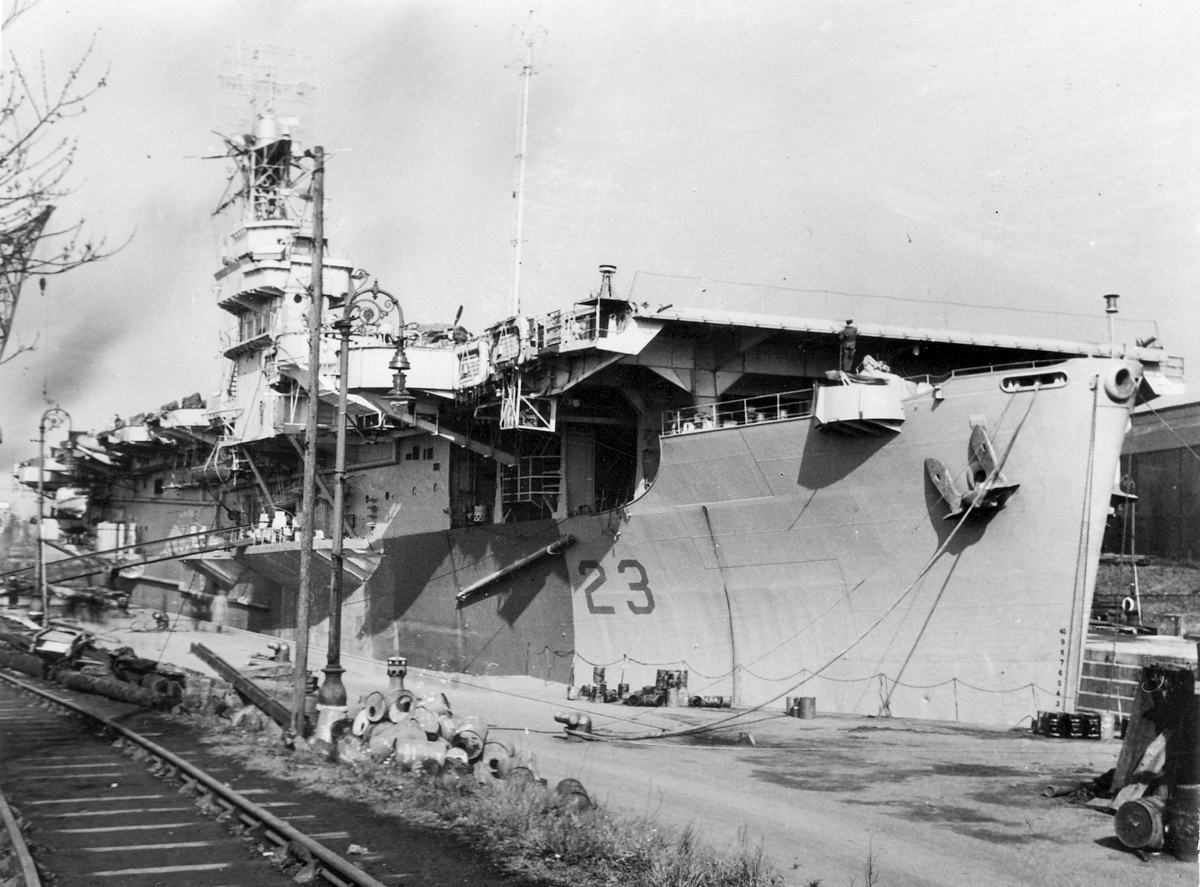
HMS PREMIER in dry-dock at Glasgow March 1945.
After storing ship PREMIER put to sea for flying exercises in the Firth of Clyde on the 12th, and anchored in Rothesay overnight. On the 13th she conducted A/S exercises in the Firth of Clyde before returning to the Tail of the Bank. On the 15th Divisions where held on the flight deck before the ship got under way to return to Scapa Flow.
Operation ROUNDEL: PREMIER was not idle on her arrival back at Scapa; she was at sea on April 17th. With the Cruiser BELLONA, escort carrier VINDEX, destroyers OFFA, ZEALOUS, ZEPHYR, ZEST, ZODIAC, CANADIAN Destroyers HAIDA, HURON and IROQUOIS and Norwegian STORD. The force was to be part of the escort for Russian Convoy JW.66 codename operation ROUNDEL. The force met with the 22 ship convoy the following day. Aircraft from both carriers flew A/S patrols most days until Kola Inlet, but there were no incidents on the outward voyage, all ships arrived safely at the Kola Inlet on the 25th.
The ships of the escort force spent the next five days anchored in Vaenga Bay preparing for the return voyage with convoy RA.66 which sailed for the Clyde on the 29th with 24 merchant ships. The return voyage was to see the last convoy battle of the war as a 14 strong U-Boat pack laid in wait for the convoy off the Kola Inlet.
In addition to the escorting force that PREMIER was a part of there were elements of the 19th Escort Group operating specifically against these U-Boats. Frigates ANGUILLA, COTTON, LOCH LNSH and LOCH SHIN of the 19th EG hunted and destroyed U-307 followed by U-286; the last U-boats sunk by warships of the Royal Navy. The frigate GOODALL of the 19th EG was torpedoed by U-968 and went down with heavy loss of life; she was the last major warship of the Royal Navy lost in the war against Germany. Aircraft from PREMIER and VINDEX carried out patrols and drove off shadowing aircraft. 856 Squadron suffered some crashes on deck, two Avengers (JZ521 'PG' and JZ529 'PK') ended up taking the barrier on May 1st while the day before an Avenger (JZ532 'PE') suffering from heavy icing stalled on approach to the round down and hit it. . Fire broke out but the flight deck crew had it out very quickly. The pilot Sub-Lt A. S. Murray, RNVR was seriously injured; Sub-Lt N. Muir, RNVR & Leading Airman S. A. Crawford were unhurt, all managed to walk off the wing onto the flight deck. The aircraft was a write off and was jettisoned into the sea. 856 Squadron flew the last A/S patrol of the last Russian convoy of the war, landing on at 02:35 on the morning of May 7th.
HMS PREMIER and the escorting force broke away off Orkney and returned to Scapa Flow on the 7th, convoy RA.66 arrived safely in the Clyde on May 8th. On arriving at Scapa the news that Germany was to surrender was received and celebrations began. 856 Squadron disembarked to
RNAS Hatston on the 8th of May and the Wildcat flight was withdrawn. This was the end of the squadron's association with PREMIER; they saw no further operational service and disbanded at Hatston on June 15th.
On May 21st HMS PREMIER arrived at Greenock and was transferred toe control of Rosyth Command for a tour as a Deck Landing Training Carrier. Before beginning this new duty she was to undergo a period of defect ratification work and was to spend the next five weeks in dockyard hands before she was ready to begin DLT operations in the Clyde exercise areas at the beginning of July.
The first period of intense DLT was July 3rd to the 25th when the ship was visited by a variety of aircraft from 768 DLT squadron from RNAS Ayr (including Corsair, Barracuda, and Swordfish), in addition the Hellcats of 892 Squadron from RNAS Eglinton and the Corsairs of 1835 from RNAS Belfast utilised the ship for pre-deployment training.
The Hellcats of 892 were first to fly out to the ship on July 2nd and there were two accidents on this date: JV213 flown by Mid A. A. Ford, RNVR made a good landing but the aircraft rolled back into the barrier which had been raised ready for the next landing. JX822 flown by Mid P. H. M. Menrhenitt, RNVR was lost overboard after braking hard while taxying forward and went over the bow, the pilot was safely rescued. On the 3rd FN399 flown by Mid R. F. Underwood, RNVR caught No.8 wire, entered the barrier, the following day Sub-Lt R. F. Collinge, RNVR landing in FN367 lost his arrester hook after it snagged on a patch on the rounddown and was torn out on catching No.1 wire before entering the barrier. There were two other accidents on the 25th: Corsair KD217 ('G') of 1835 Sqn flown by Sub-Lt R. S. O. Pryka, RNVR drifted port on crossing the threshold and its wing hit the Deck Landin Control Officer's screen, and the undercarriage of Swordfish NF195 piloted by Sub-Lt H. J. C. Spencer, RNVR collapsed on landing.
After a short break a second series of DLT sessions were undertaken 21st to the 25th of August for aircraft of 768 DLT Squadron and 748 Sqn from RNAS Dale. There is only one landing incident for this period on the 21st, Seafire NN198 of 748 Sqn flown by Sub-Lt G. M. J. Brown, RNZNVR caught No.7 wire and the prop clipped the barrier. 768e squadron moved from RNAS Ayr to RNAS Ballyhalbert, Northern Ireland after this period of training and it was from this new base that aircraft flew out to PREMIER during 11th to the 27th September.
There were three deck crashed during the September session: on the 13th Seafire NN198 of 748 Sqn had its second incident, this time flown by Sub-Lt G. F. Budd, RNZNVR, the aircraft bounced cleared nearly all the wires before catching No.8 wire and entering the barrier. There were two Corsair crashes both 768 machines; on the 18th Sub-L D. J. Leslie, RNVR in Corsair JT409 missed all the wires and entered the barrier, and on the 19th Sub-Lt J. A. Tyrrell, RNVR in JT327 caught No8 wire and entered the barrier.
After a brief, and uneventful, training period for pilots of 802 Squadron flying Seafire XVs from RNAS Ayr 23rd to the 29th October HMS PREMIER began a refit in a Clyde shipyard. On returning to active duty in early November PREMIER carried out a post refit shakedown, this included flight deck testing with a Seafire XV from 778 Service Trials Unit on November 12th. On resuming her DLT Duties she again operated with 768 Sqn and 802 Squadron's Seafire F.XVs between the 19th to the 30th November in the Clyde area.
There were four deck crashes during November: on the 12th Sub-Lt S. N. Harris, RNVR in Seafire SW908 (778 Sqn) made a heavy landing and the starboard oleo collapsed. The other three were all by pilots from 802 Sqn, on the 19th Sub-Lt G. C. Davis, RNVR flying in SW804 (named MEPHISTOPHELES III) missed all the wires and flew into the barrier. On the 23rd Sub-Lt Davies had his second barrier crash in SW915 (named HILDEBRAND III), he touched down aft of No.1 wire, bounced and caught No.8 wire, and finally on the 26th Sub-Lt H. L. Pyrah, RNVR in SW900 struck the rounddown with his hook and damaged the rudder.
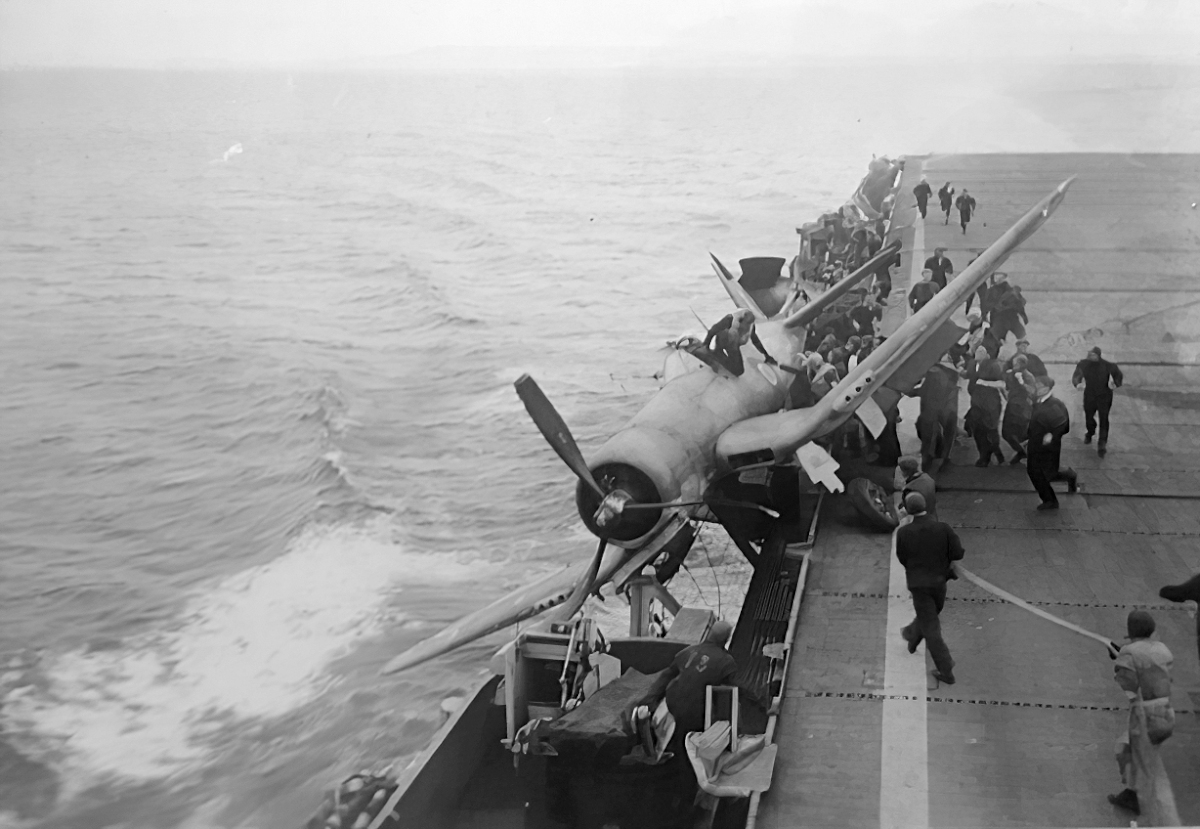

In the New Year PREMIER operated on the east coast of Scotland, providing DLT facilities for 767 and 768 squadrons based at RNAS East Haven; both squadrons operated with PREMIER on January 18th and 19th. 767 Sqn operated with the ship for the last time on February 4th, and pilots of 768 made final landings on the 17th. Three Barracudas had been attached to PREMIER as a ship's flight during February, one aircraft, LS796 crashed into the rounddown at 13:15 on February 11th causing considerable damage to the rounddown; the aircraft fell into the sea and the pilot was rescued by the plane guard destroyer, the passenger, a Lieutenant from the Royal Dutch Navy was not found and was presumed drowned. The remaining two Barracudas were craned of onto Lighters on the 22nd when PREMIER completed her DLT duty.
Once her duties as a Deck Landing Carrier were completed HMS PREMIER commenced de-storing in Rosyth Dockyard in preparation for her return to the US Navy. During early March all admiralty equipment was removed and the majority of her ship's company were drafted to other billets, leaving a steaming party on board for her final Atlantic crossing. This was to be trooping run to Canada on route to Norfolk, Virginia and she embarked 36 Canadian Officers & 395 other ranks, 19 Naval Officers & 12 ratings plus 6 Civilians on March 22nd. Also on board were 60 airframes for disposal at sea. She sailed at 09:00 on the 24th bound for Halifax, Nova Scotia, and ditched her aircraft overboard the following day. She arrived at Halifax at 09:00 on April 1st and disembarked troops, naval personal and civilian passengers, before sailing for Norfolk at 13:00 hours.
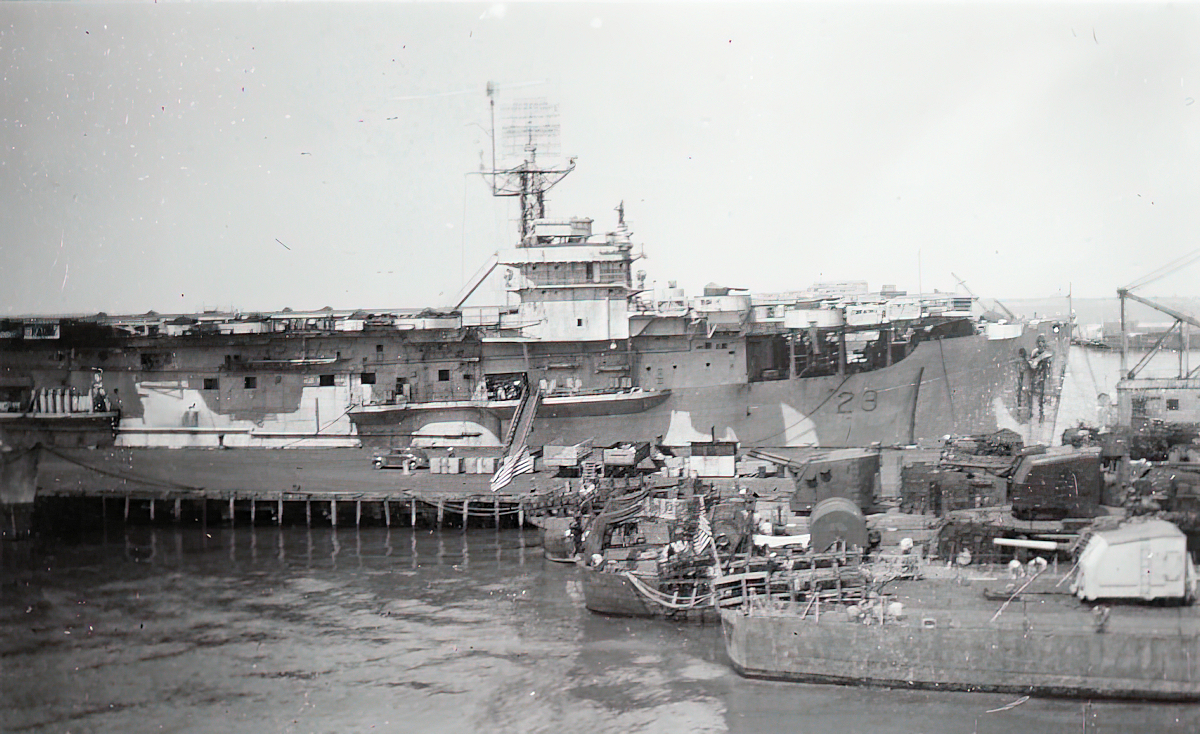
CVE-42 ex HMS PREMIER at Norfolk Navy Yard c. April 1946. Photo: From the collection of RM1c Dale Magnus, USN
HMS PREMIER arrived in Norfolk Navy Yard on April 3rd and berthed at pier 7 at 16:30 at which time she was decommissioned. CVE-42 was returned to US Naval custody at Norfolk on April 2nd 1946, and was stricken for disposal on May 21st 1946.
The vessel was sold for commercial service and was converted to a cargo liner by Gulf Shipbuilding Corp., Mobile, Alabama. She was acquired by Blue Star Line Ltd. And renamed RHODESIA STAR and she operated on U.k. to South Africa, Australia & New Zealand routes, also operated out of some European ports on home trade routes. . In 1967 she was sold to International Export Lines Ltd., Bahamas, and renamed HONG KONG KNIGHT operating on West coast America, Taiwan, Japan & Hong Kong routes. She was sold to Ta Yung Steel Corp., Taiwan in 1974 for scrapping and was broken up at Kaohsiung, Taiwan, starting February 10th 1974.
Last modified: 01 July 2022
© 1999-2024 The Royal Navy Research Archive All Rights Reserved Terms of use Powered byW3.CSS
Press F5 to refresh the page after posting your comment or to hide the form
Shape: Standard, circular.
Blazon (Heraldic description) On a blue field: a bezant thereon a billet, black, within a chaplet of roses, red, barbed and leaved, green.
PREMIER: Having the prime qualities of pure gold, the strength of steel and the integrity of silence and honesty. The elements of the design reflect these qualities; the Bezant is a gold coin while the Billet a steel bar. The Rose is an ancient symbol of purity.
For explanations of heraldic terms see the
Royal
Navy Ship's Badges page.
Note: 852 Squadron had formed in the US at USNAS Squantum, Massachusetts on November 1st 1943 with 12 Avenger TBR MK. I aircraft. The squadron had flown out to San Francisco in order to join NABOB at the earliest opportunity. They had nearly a month in which to operate from the ship and work up both pilots and NABOB's air departments before her deck was filled with non-flying airframes as deck cargo.
CloseWhere is TRUMPETER?
She was in company at the time of the torpedo hit, is pictured standing off while preparations to abandon ship are underway. Home Fleet War Diary lists TRUMPETER as escorting NABOB to the Faroes and then on to Scapa, both ships arriving on the 27th. So why did Lt. Cdr Bradshaw need to launch two Avengers for A/S patrol when TRUMPETER carried 9 Avengers and 4 Wildcats herself?
Note: It is unclear which escorts remained with NABOB; KEMPTHORNE and KEATS appear to have remained with the two Carriers and AYLMER and BLIGH may have stayed with KENT when the force dispersed.
CloseNote:Sub Lt Gowan RNZNVR was later awarded the DSC for skill and leadership in dive-bombing and strafing missions during 'Operation Dragoon'
CloseNote: Several commentators have ATTACKER arriving at Taranto for refit on Dec 6th with squadron personnel taking passage to Egypt in the Italian cruiser DUCA D'AOSTA. However, squadron records show that the aircraft of both 809 and 879 squadrons were disembarked from ATTACKER on Dec 11th in Egypt.
Close
Comments (0)